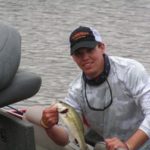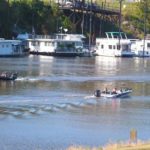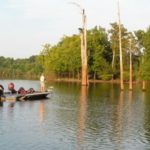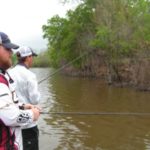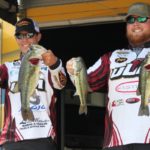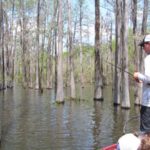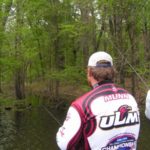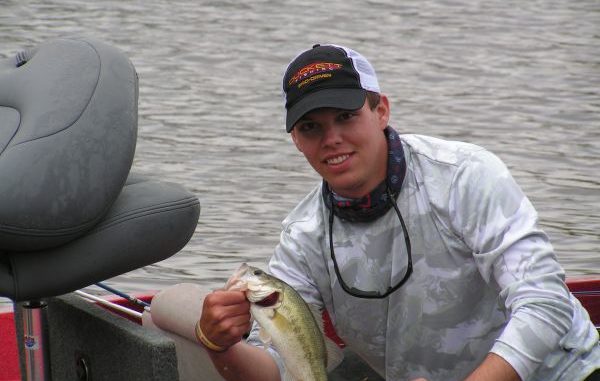
The Ouachita River stretches from north of the Arkansas state line to the Tensas River west of Sicily Island, and it’s packed with bass. These college students provide some lessons on how to catch them.
Trapper Munn navigated the boat out of the big river and through the trees into the small river lake off the Ouachita River. In several spots, subtle current came around points and over shallow sandbars.
Up in the lake, standing timber offered a multitude of hiding places for largemouth bass.
To the right, there was a bank with treetops, grass growing out 8 to 10 feet and a couple of small runouts where the water from a recent rainstorm trickled into the lake. Huge century-old cypress trees had left huge stumps as a reminder of their past presence.
“Let’s try it here,” Munn’s fishing partner, Dustin Perkins said.
Dustin stepped up to the front of the boat, and the duo began casting Sweet Beaver soft plastics and War Eagle spinnerbaits at various points of structure.
Thirty minutes later, the duo hadn’t had a bite.
“This can be the biggest problem fishing the Ouachita River,” Perkins said. “There are so many places that look so good, I tend to stay and fish where I shouldn’t.
“If you aren’t catching fish, you need to move on and try something else. Maybe the same type of structure, maybe something different. Don’t spend too much time in unproductive areas because it looks good. It all looks good. You’ll waste the whole day.”
That pretty much sums up what stumps many summer anglers on the Ouachita. The meandering river flows from the Arkansas state line all the way to where it meets the Tensas River and forms the Black River near Jonesville.
It’s a big river, full of bayous, runouts and dozens of river lakes.
For today’s lesson, we are going to let a couple of young river professors — um, I mean fishermen — take us to summer school, University of Ouachita River style. The young duo doesn’t claim to be the best fishermen on the river, but they are good.
And their fresh perspective and unique experiences offer a combination of lessons learned and insight into choosing the correct answers on the multiple-choice largemouth bass test.
Perkins and Munn gained national attention earlier this spring when the two University of Louisiana at Monroe fishermen topped 77 other teams from eight states to win the Bassmaster Central Regional on the Ouachita, logging a two-day catch of 19 pounds, 6 ounces.
They will be one of 12 central-division teams in the Bassmaster College National Championship on Chatuge Reservoir in Georgia on July 31-Aug. 2.
Here’s their textbook approach to catching summer river bass, with the focus on the north end of the big river.
Chapter one: River lakes
“Obviously, when fishing the Ouachita, river lakes and backwater lakes are going to be the hotspots,” Perkins said. “There are some that you can’t get in unless the water is high, but there are dozens more that are accessible all year.
“There are going to be bass in those lakes all the time.”
The most-important thing to do in the river lakes is find good water. This duo does that by simply doing a look-at-a-bait test.
“If you put your bait 2 inches under the water, and you can’t see it, then the fish can’t see it either,” said Perkins. “I like to find water where I can see the bait at least a foot deep. In the summer, it’s easy to find water with 2 feet or better visibility. That is where you’ll catch fish.”
Then, as Munn says, “Just go fishing.”
“It’s like fishing anywhere else,” the Oak Grove angler said. “Find an area you like. I like to pitch and flip the trees and stumps. Sometimes fish will be near the mouths of the lakes or along runoffs, but there can be bass anywhere.
“Some fish move in and out, but a good number of bass live in river lakes that never see the actual river.”
Best bait? The answer comes in stereo.
“We fish the Sweet Beaver plastic lure almost anywhere, Perkins said. “Just pitch it by a tree or laydown and let it fall. They hit it just like a worm.
“Retrieve it in a pumping motion to maximize the time you have with the lure falling.”
Favorite colors are black-and-blue and watermelon red.
Munn also swears by the Strike King KVD 1.5 crankbait in chartreuse or shad colors, depending on water clarity.
“It works well in the river, and it deflects off the cover really well,” he said. “I especially like it around fallen logs and cypress trees.”
They also fish a variety of frogs, worms and other weedless lures that can be cast way back into the thickest of structure. They use a three-pop-and-sit retrieve on the frog: Cast it out deep in the structure and give three short retrieves — pop, pop, pop — and then let the then ripples disappear. Repeat the process, if an aggressive largemouth hasn’t already popped the lure back.
Some of the most-popular river lakes between the Arkansas line and Monroe include Bayou Loutre Basin, Moon Lake, White’s Lake and backwater areas up Bayou D’Arbonne.
Bayou D’Arbonne is probably the most-popular bass area on the river (see more about it in the sidebar story). Farther south toward Columbia, one of the largest fishing lakes is Riverton Lake.
Chapter Two: The current
With the exception of a long, hot, dry summer with no rain and no release of water from huge reservoirs in Arkansas, there is good current fishing for bass all along the Ouachita.
And sandy points, sharp river bends, laydowns and numerous bayous and cuts coming into the river offer great current fishing.
“There’s good current and bad current,” Perkins explained.
The Pineville anglers also fishes the Red River system frequently, and he said it is very similar to the Ouachita.
“You don’t want the current to be too strong or in too big of an area,” Perkins said. “Find slow-moving current, toss your bait in it and let it carry down through the current.”
Effectively using the current isn’t a sedentary game, however.
“To successfully current fish, you have to run the river and hit a lot of spots — a wing dam, fallen trees, anything that breaks off the current and has slack water behind it,” Munn said. “The slack water is the key. Bass will position right behind the current in the slack water and ambush the bait.
“Don’t just throw one bait here. Try a little bit of everything, even if you are catching fish.”
Some of the more-popular creeks and bayous include Frank Lapere Creek, Bayou DeButte, Boggy Bayou and the Bayou DeLoutre north of Monroe.
As you move south, there are Pinder Branch, Lake Lfitta, Long Grove Bayou and many more. Many of these stops are named on maps, but there are dozens smaller ones that aren’t charted.
Also, the mouths to the lakes mentioned in Chapter One provide excellent current fishing.
Here’s a key tip: Don’t just fish right up on the points where current is most obvious. Instead, fish baits deeper 10 to 20 feet off the point or bank.
Chapter Three: Knowing the river
There are plenty of great places to fish from Lock and Dam No. 6 at Felsthensal just north of the Louisiana state line to the Columbia Lock and Dam at Columbia — and there is also a lot of easy access.
With the price of gasoline, the best bet for bass fishing the river is to choose an area you want to fish and put in close by that area.
Just south of the state line is the Finch Bayou Landing (aka Alabama Landing), and there is also a landing on the Ouachita side at Sterlington. Both of these facilities provide multi-lane, well-maintained ramps with plenty of parking.
The Monroe area has three big landings: Moon Lake to the north, Forsythe Park in the city and Lazarre Point on the West Monroe side to the south.
Prairion Bayou Recreational Area is the last major area south of Monroe before Columbia.
Near Columbia, the Columbia Lock and Dam offers access from both sides of the river and there is a large landing on Pearl Street in the town of Columbia.
Because of the water fluctuation, gasoline and supplies are limited on the river. So make sure to stop in town and get what you need for a good trip.
Here’s another important tip: The Ouachita is really busy in the summer, especially on weekends. Watch out for vessels from kayakers to houseboaters, plus skiers, tubers and swimmers.
If the river is on the rise and has a good current, watch for floating debris, especially logs. There is even some barge traffic on the river, so don’t cut those sharp bends too closely when running the river.
Now, it’s time for the test. You did know there was a test, right?
Load up your boat, pick out your favorite type spot and take out your rod and reel and begin casting. You have the next three months to complete the test.
Hopefully you can use the information you’ve learned here to help you make the grade landing Ouachita River largemouths.
